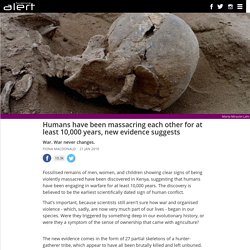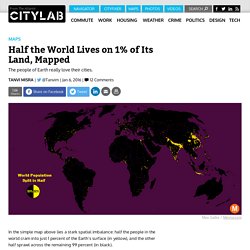

Jer Thorp: Make data more human. General Chapman’s Last Stand. StarTalk Live! at Kings Theatre: Science and Morality (Part 2) Spreaker Spreaker StarTalk Live!

At Kings Theatre: Science and Morality (Part 2) Confronting Stigma. Nas Daily - This took me a while to share. But here it... Trust Me (Rebroadcast) Humans have been massacring each other for at least 10,000 years, new evidence suggests. Fossilised remains of men, women, and children showing clear signs of being violently massacred have been discovered in Kenya, suggesting that humans have been engaging in warfare for at least 10,000 years.

The discovery is believed to be the earliest scientifically dated sign of human conflict. That's important, because scientists still aren't sure how war and organised violence - which, sadly, are now very much part of our lives - began in our species. Were they triggered by something deep in our evolutionary history, or were they a symptom of the sense of ownership that came with agriculture? The new evidence comes in the form of 27 partial skeletons of a hunter-gatherer tribe, which appear to have all been brutally killed and left unburied. A team from the University of Cambridge in the UK found evidence that the individuals - including women and children - had been subjected to injuries such as extreme blunt-force trauma, broken bones, and arrow lesions to the neck.
Businessinsider. 2020 is shaping up to be a big year for us: the U.S.

Census Bureau estimates that “more than half of the nation’s children are expected to be part of a minority race or ethnic group;” LG plans to have tripled its solar panel production by then; there’ll be another Olympic Games; and, oh yeah, robots will apparently take over some five million jobs. It’s the latest in a series of figures economists have released projecting the impact that AI systems and machines will have on the human workforce, and this one, from the World Economic Forum, predicts a “Fourth Industrial Revolution,” characterized by unprecedented “developments in genetics, artificial intelligence, robotics, nanotechnology, 3D printing, and biotechnology.”
And while previous industrial revolutions have catapulted the human workforce forward, this one may set us back — at least in the short term. The Changing Face of Saudi Women. POWER BRUNCH, SAUDI VERSION Aljazi Alrakan (standing), a dentist and self-described lifestyle blogger, joins friends in a fashionable Riyadh restaurant.

Medicine and teaching were careers open to Saudi women early on; both suited a single-sex clientele. With more women than men now in universities, “there are new careers,” Alrakan says. “I look at girls in their early 20s, and I think, They carry themselves more confidently.” By Cynthia Gorney. Interpretare Colonia, fuori dai bar. For the second time in human history, we are witnessing a new geological epoch. 11,700 years ago, the Earth suffered a catastrophic climate change.

As the ice age ended, sea levels rose by 120 meters, the days grew warmer, and many kinds of plant and animal life died out. But one animal began to thrive more than ever before. Homo sapiens, which had already spread to every continent except Antarctica, came up with a new survival strategy. Today, we call it farming. Thanks in part to that innovation, humans survived to witness the dramatic transition from the Pleistocene epoch to the Holocene—it was the first such geological transition in almost 2 million years. Why Americans Work So Much Despite Economist John Maynard Keynes's Prediction.
How will we all keep busy when we only have to work 15 hours a week?

That was the question that worried the economist John Maynard Keynes when he wrote his short essay “Economic Possibilities for Our Grandchildren” in 1930. Over the next century, he predicted, the economy would become so productive that people would barely need to work at all. For a while, it looked like Keynes was right: In 1930 the average workweek was 47 hours.
By 1970 it had fallen to slightly less than 39. Most Americans Aren’t Middle Class Anymore. Kathryn Donohew Photography / Getty Images Presidential hopefuls from both parties have been saying throughout the primary campaign that the American middle class is in trouble.

Bernie Sanders says it is in the midst of “a 40-year decline.” Jeb Bush says it is “shrinking.” Ted Cruz says it is “headed in the wrong direction.” And Hillary Clinton says the “basic bargain” that hard work could move families into the middle class “has eroded.” What Ever Happened to Metrosexuals? This article originally appeared on VICE UK.

When I was 13, I got really into hair products: Wella Shock Waves Gel, Wet Look VO5, Fudge Styling Wax, L'Oreal Extra Strength, Aussie Mousse, basically anything that promised to texture, control, or volumize my greasy crown. At one point I was applying several of these gloopy potions daily, ruffing my follicles into a crispy, lacquered mess. Beneath the fiberglass meringue that was my barnet you would usually find a combination of Paul Smith aftershave, Nivea moisturizer, Levi's engineered jeans (straight from Cromwell's Madhouse), and reproduction 70s football training tops with "BRA" on one side and "ZIL" on the other. It would have been a ridiculous look for anyone, but especially for a 13-year-old. Half the World Lives on 1% of Its Land, Mapped. The people of Earth really love their cities.

In the simple map above lies a stark spatial imbalance: half the people in the world cram into just 1 percent of the Earth’s surface (in yellow), and the other half sprawl across the remaining 99 percent (in black). Data viz extraordinaire Max Galka created this map using NASA’s gridded population data, which counts the global population within each nine-square-mile patch of Earth, instead of within each each district, state, or country border. Out of the 28 million total cells, the ones with a population over 8,000 are colored in yellow.